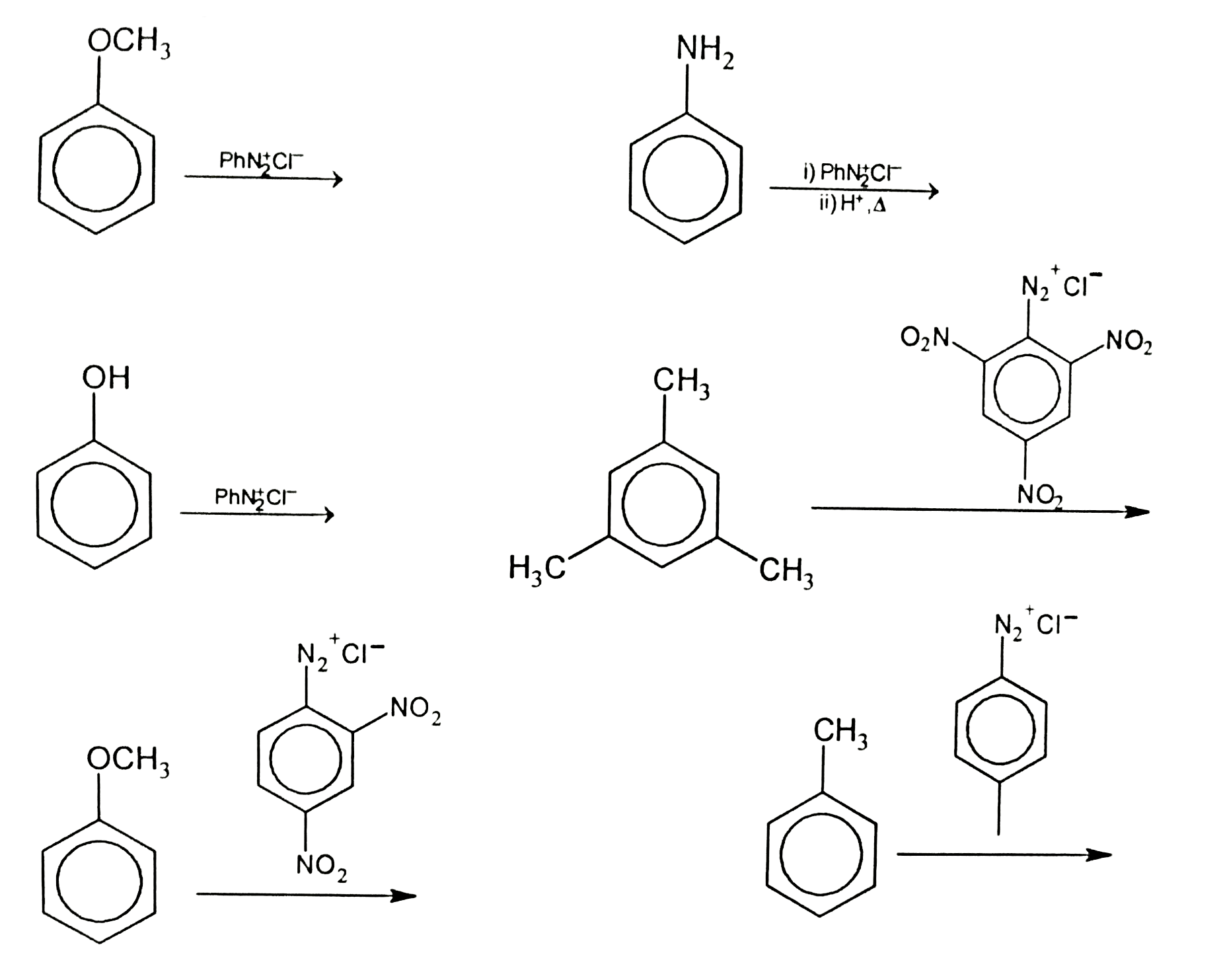What is a coupling reaction?
Step-by-Step Solution:
1. Definition of Coupling Reaction:
A coupling reaction is a type of chemical reaction where two molecules combine to form a larger molecule, typically involving an electrophilic substitution mechanism.
2. Involvement of Diazonium Salts:
In coupling reactions, diazonium salts react with aromatic compounds that have electron-rich groups. These electron-rich groups can include functional groups such as -OH (hydroxyl) and -NH2 (amino).
3. Formation of Azo Compounds:
The result of the coupling reaction is the formation of azo compounds, which contain the functional group -N=N- (azo group). These compounds are often brightly colored and are used as dyes.
4. Example of a Coupling Reaction:
A common example is the reaction of benzene diazonium chloride with phenol in a basic medium.
- Reactants: Benzene diazonium chloride (C6H5N2Cl) and phenol (C6H5OH).
- Reaction: In the presence of a base, the diazonium group (N2+) of benzene diazonium chloride reacts with the electron-rich aromatic ring of phenol.
- Product: The product formed is para-hydroxyazobenzene (C6H5-N=N-C6H4(OH)), which is an orange dye.
5. Byproducts:
During this reaction, byproducts such as hydrochloric acid (HCl) and water (H2O) are also formed.
6. Visual Representation:
To visualize the reaction, you can represent benzene diazonium chloride as a benzene ring with a diazonium group (N2+) attached, and phenol as a benzene ring with a hydroxyl group (-OH). The coupling occurs at the para position relative to the hydroxyl group on the phenol.
A coupling reaction is a type of chemical reaction where two molecules combine to form a larger molecule, typically involving an electrophilic substitution mechanism.
In coupling reactions, diazonium salts react with aromatic compounds that have electron-rich groups. These electron-rich groups can include functional groups such as -OH (hydroxyl) and -NH2 (amino).
The result of the coupling reaction is the formation of azo compounds, which contain the functional group -N=N- (azo group). These compounds are often brightly colored and are used as dyes.
A common example is the reaction of benzene diazonium chloride with phenol in a basic medium.
- Reactants: Benzene diazonium chloride (C6H5N2Cl) and phenol (C6H5OH).
- Reaction: In the presence of a base, the diazonium group (N2+) of benzene diazonium chloride reacts with the electron-rich aromatic ring of phenol.
- Product: The product formed is para-hydroxyazobenzene (C6H5-N=N-C6H4(OH)), which is an orange dye.
During this reaction, byproducts such as hydrochloric acid (HCl) and water (H2O) are also formed.
To visualize the reaction, you can represent benzene diazonium chloride as a benzene ring with a diazonium group (N2+) attached, and phenol as a benzene ring with a hydroxyl group (-OH). The coupling occurs at the para position relative to the hydroxyl group on the phenol.
Similar Questions
How many of these gives coupling reaction:

View SolutionArenediazonium ion are weak electrophiles, they react with highly reactive aromatic compounds with phenols and tertiary aryl amines to yeild azo compounds. This electrophilic substitution is often called a diazo coupling reaction.
What is the major product of given reaction?

View Solution
Knowledge Check
Which of the following compounds can give coupling reaction with benzene diazonium salt ?
A B
B C
C D
D
Arenediazonium ion are weak electrophiles, they react with highly reactive aromatic compounds with phenols and tertiary aryl amines to yeild azo compounds. This electrophilic substitution is often called a diazo coupling reaction.
What is the major product of given reaction?

View SolutionYellow dye can be prepared by a coupling reaction of benzene diazonium chloride in acid medium with x. Identify X from the following
View SolutionArenediazonium ion are weak electrophiles, they react with highly reactive aromatic compounds with phenols and tertiary aryl amines to yeild azo compounds. This electrophilic substitution is often called a diazo coupling reaction.
What is the major product of given reaction?

The product (P) is
View SolutionExplain the following reactions :
(a) Gabriel Phthalimide reaction
(b) Coupling reaction
View SolutionAniline does not give coupling reactions at pH <5 because :
View SolutionWhich of the following pair make fastest coupling reaction in acidic medium?
View SolutionUnder the reaction condition (acidic, basic) the coupling reaction of aryl diazonium chloride with aniline is carried out?
View Solution
